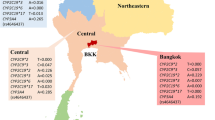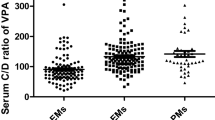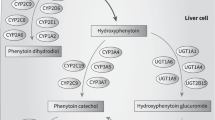Abstract
Phenytoin, an anticonvulsant, exhibits nonlinear pharmacokinetics with large interindividual differences. Because of its small therapeutic range with the risk of therapeutic failure or adverse drug effects in susceptible persons, therapeutic drug monitoring is frequently applied. The interindividual differences in dose response can partially be explained by known genetic polymorphisms in the metabolic enzyme CYP2C9 but a large deal of individual variability remains still unexplained. Part of this variability might be accounted for by variable uptake of phenytoin, which is a substrate of p-glycoprotein, encoded by the human MDR1 gene. We evaluated, whether phenytoin plasma levels correlate with a polymorphism in the MDR1 gene, C3435T, which is associated with intestinal PGP activity. Genotyping and analyses of plasma levels of phenytoin and metabolites in 96 healthy Turkish volunteers showed that the MDR1C > T3435 polymorphism affects phenytoin plasma levels (P = 0.064) and the metabolic ratio of p-HPPH vs phenytoin (MDR1*TT genotype, P = 0.026). The MDR1*CC genotype is more common in volunteers with low phenytoin levels (P ≤ 0.001, χ2 test). A combined analysis of variable alleles of CYP2C9, 2C19 and MDR1 revealed that the number of mutant CYP2C9 alleles is a major determinant, the number of MDR1*T alleles further contributes to the prediction of phenytoin plasma levels and CYP2C19*2 does not explain individual variability. The regression equation that fitted the data best included the number of mutant CYP2C9 and MDR*T alleles as predictory variables and explained 15.4% of the variability of phenytoin data (r2 = 0.154, P = 0.0002). Furthermore, analysis of CYP2C9 and MDR1 genotypes in 35 phenytoin-treated patients recruited from therapeutic drug monitoring showed that combined CYP2C9 and MDR1 analysis has some predictive value not only in the controlled settings of a clinical trial, but also in the daily clinical practice.
This is a preview of subscription content, access via your institution
Access options
Subscribe to this journal
Receive 6 print issues and online access
$259.00 per year
only $43.17 per issue
Buy this article
- Purchase on Springer Link
- Instant access to full article PDF
Prices may be subject to local taxes which are calculated during checkout




Similar content being viewed by others
References
Fritz S, Lindner W, Roots I, Frey BM, Küpfer A . Stereochemistry of aromatic phenytoin hydroxylation in various drug hydroxylation phenotypes in humans J Pharmacol Exp Ther 1987 241: 615–622
Yasumori T, Chen LS, Li QH, Ueda M, Tsuzuki T, Goldstein JA et al. Human CYP2C-mediated stereoselective phenytoin hydroxylation in Japanese: difference in chiral preference of CYP2C9 and CYP2C19 Biochem Pharmacol 1999 57: 1297–1303
Veronese ME, Doecke CJ, Mackenzie PI, McManus ME, Miners JO, Rees DL et al. Site-directed mutation studies of human liver cytochrome P-450 isoenzymes in the CYP2C subfamily Biochem J 1993 289: 533–538
De Morais SM, Wilkinson GR, Blaisdell J, Meyer UA, Nakamura K, Goldstein JA . Identification of a new genetic defect responsible for the polymorphism of (S)-mephenytoin metabolism in Japanese Mol Pharmacol 1994 46: 594–598
De Morais SM, Wilkinson GR, Blaisdell J, Nakamura K, Meyer UA, Goldstein JA . The major genetic defect responsible for the polymorphism of S-mephenytoin metabolism in humans J Biol Chem 1994 269: 15419–15422
Ferguson RJ, De Morais SM, Benhamou S, Bouchardy C, Blaisdell J, Ibeanu G et al. A new genetic defect in human CYP2C19: mutation of the initiation codon is responsible for poor metabolism of S-mephenytoin J Pharmacol Exp Ther 1998 284: 356–361
Mamiya K, Ieiri I, Shimamoto J, Yukawa E, Imai J, Ninomiya H, Yamada H et al. The effects of genetic polymorphisms of CYP2C9 and CYP2C19 on phenytoin metabolism in Japanese adult patients with epilepsy: studies in stereoselective hydroxylation and population pharmacokinetics Epilepsia 1998 39: 1317–1323
Odani A, Hashimoto Y, Otsuki Y, Uwai Y, Hattori H, Furusho K et al. Genetic polymorphism of the CYP2C subfamily and its effect on the pharmacokinetics of phenytoin in Japanese patients with epilepsy Clin Pharmacol Ther 1997 62: 287–292
Juliano RL, Ling V . A surface glycoprotein modulating drug permeability in Chinese hamster ovary cell mutants Biochim Biophys Acta 1976 455: 152–162
Seelig A . A general pattern for substrate recognition by P-glycoprotein Eur J Biochem 1998 251: 252–261
Ambudkar SV, Dey S, Hrycyna CA, Ramachandra M, Pastan I, Gottesman MM . Biochemical, cellular, and pharmacological aspects of the multidrug transporter Annu Rev Pharmacol Toxicol 1999 39: 361–398
Thiebaut F, Tsuruo T, Hamada H, Gottesman MM, Pastan I, Willingham MC . Cellular localization of the multidrug-resistance gene product P-glycoprotein in normal human tissues Proc Natl Acad Sci U S A 1987 84: 7735–7738
Ueda K, Clark DP, Chen CJ, Roninson IB, Gottesman MM, Pastan I . The human multidrug resistance (mdr1) gene. cDNA cloning and transcription initiation J Biol Chem 1987 262: 505–508
Cordon-Cardo C, O'Brien JP, Boccia J, Casals D, Bertino JR, Melamed MR . Expression of the multidrug resistance gene product (P-glycoprotein) in human normal and tumor tissues J Histochem Cytochem 1990 38: 1277–1287
Fromm MF . P-glycoprotein: a defense mechanism limiting oral bioavailability and CNS accumulation of drugs J Pharmacol Exp Ther 2000 293: 376–382
Hoffmeyer S, Burk O, von Richter O, Arnold HP, Brockmöller J Johne A et al. Functional polymorphisms of the human multidrug-resistance gene: multiple sequence variations and correlation of one allele with P-glycoprotein expression and activity in vivo Proc Natl Acad Sci U S A 2000 97: 3473–3478
Aynacioglu AS, Brockmöller J, Bauer S, Sachse C, Güzelbey P, Öngen Z et al. Frequency of cytochrome P450 CYP2C9 variants in a Turkish population and functional relevance for phenytoin Br J Clin Pharmacol 1999 48: 409–415
Aynacioglu AS, Sachse C, Bozkurt A, Kortunay S, Nacak M, Schröder T et al. Low frequency of defective alleles of cytochrome P450 enzymes 2C19 and 2D6 in the Turkish population Clin Pharmacol Ther 1999 66: 185–192
Stubbins MJ, Harries LW, Smith G, Tarbit MH, Wolf CR . Genetic analysis of the human cytochrome P450 CYP2C9 locus Pharmacogenetics 1996 6: 429–439
Yasar U, Eliasson E, Dahl ML, Johansson I, Ingelman-Sundberg M, Sjöquist E . Validation of methods for CYP2C9 genotyping: frequencies of mutant alleles in a Swedish population Biochem Biophys Res Commun 1999 254: 628–631
Ninomiya H, Mamiya K, Matsuo S, Ieiri I, Higuchi S, Tashiro N . Genetic polymorphism of the CYP2C subfamily and excessive serum phenytoin concentration with central nervous system intoxication Ther Drug Monit 2000 22: 230–232
Brockmöller J, Cascorbi I, Henning S, Meisel C, Roots I . Molecular genetics of cancer susceptibility Pharmacology 2000 61: 212–227
Eichelbaum M, Evert B . Influence of pharmacogenetics on drug disposition and response Clin Exp Pharmacol Physiol 1996 23: 983–985
Bhasker CR, Miners JO, Coulter S, Birkett DJ . Allelic and functional variability of cytochrome P4502C9 Pharmacogenetics 1997 7: 51–58
Ieiri I, Mamiya K, Urae A, Wada Y, Kimura M, Irie S et al. Stereoselective 4′ hydroxylation of phenytoin: relationship to (S)-mephenytoin polymorphism in Japanese Br J Clin Pharmacol 1997 43: 441–445
Gottesman MM, Pastan I, Ambudkar SV . P-glycoprotein and multidrug resistance Curr Opin Genet Dev 1996 6: 610–617
Mickley LA, Lee JS, Weng Z, Zhan Z, Alvarez M, Wilson W et al. Genetic polymorphism in MDR-1: a tool for examining allelic expression in normal cells, unselected and drug-selected cell lines, and human tumors Blood 1998 91: 1749–1756
Schinkel AH, Mayer U, Wagenaar E, Mol CA, van Deemter L, Smit JJ et al. Normal viability and altered pharmacokinetics in mice lacking mdr1-type (drug-transporting) P-glycoproteins Pharmacogenetics 2000 10: 583–590
Schinkel AH, Wagenaar E, van Deemter L, Mol CA, Borst P . Absence of the mdr1a P-glycoprotein in mice affects tissue distribution and pharmacokinetics of dexamethasone, digoxin, and cyclosporin A J Clin Invest 1995 96: 1698–1705
Schinkel AH, Wagenaar E, Mol CA, van Deemter L . P-glycoprotein in the blood-brain barrier of mice influences the brain penetration and pharmacological activity of many drugs J Clin Invest 1996 97: 2517–2524
Lazarowski A, Sevlever G, Taratuto A, Massaro M, Rabinowicz A . Tuberous sclerosis associated with MDR1 gene expression and drug-resistant epilepsy Pediatr Neurol 1999 21: 731–734
Acknowledgements
Parts of this work were supported by grants No. 01EC9408 (Clinical Pharmacogenetics), 01GG9845, and 01GG9848 from the German Ministry for Education and Research.
Author information
Authors and Affiliations
Corresponding author
Rights and permissions
About this article
Cite this article
Kerb, R., Aynacioglu, A., Brockmöller, J. et al. The predictive value of MDR1, CYP2C9, and CYP2C19 polymorphisms for phenytoin plasma levels. Pharmacogenomics J 1, 204–210 (2001). https://doi.org/10.1038/sj.tpj.6500025
Received:
Revised:
Accepted:
Published:
Issue Date:
DOI: https://doi.org/10.1038/sj.tpj.6500025
Keywords
This article is cited by
-
Pharmacogenetics of tamoxifen therapy in Asian populations: from genetic polymorphism to clinical outcomes
European Journal of Clinical Pharmacology (2021)
-
Impact of Genetic Polymorphisms on Phenytoin Pharmacokinetics and Clinical Outcomes in the Middle East and North Africa Region
Drugs in R&D (2017)
-
Population pharmacokinetic analysis of rebamipide in healthy Korean subjects with the characterization of atypical complex absorption kinetics
Journal of Pharmacokinetics and Pharmacodynamics (2017)
-
CYP2C9, CYP2C19, ABCB1 genetic polymorphisms and phenytoin plasma concentrations in Mexican-Mestizo patients with epilepsy
The Pharmacogenomics Journal (2016)
-
The effect of polymorphic metabolism enzymes on serum phenytoin level
Neurological Sciences (2015)



